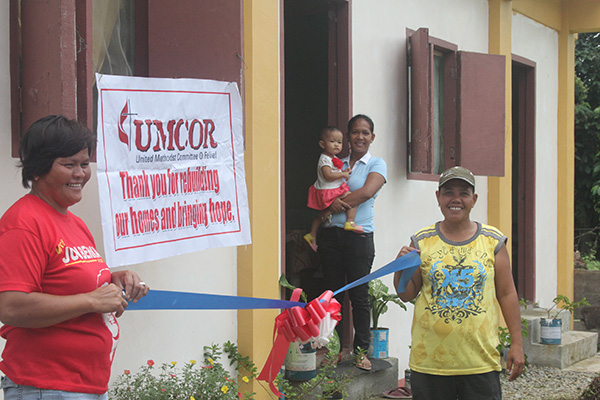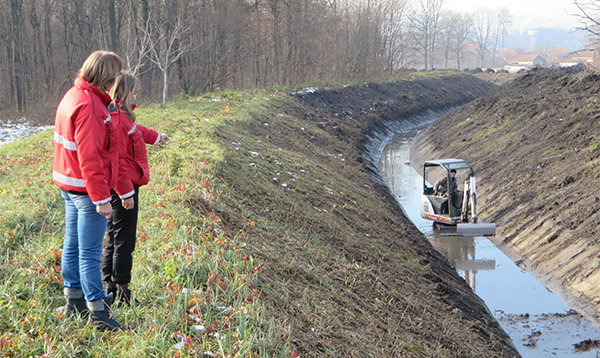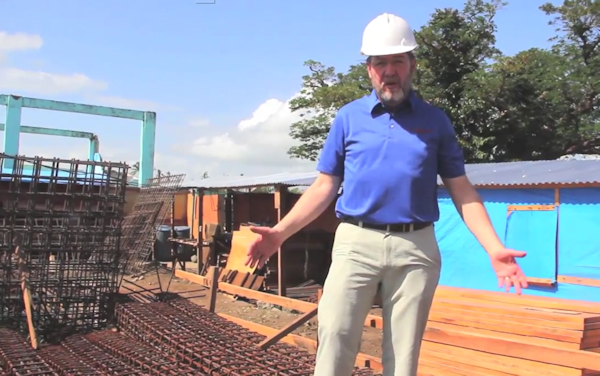The United Methodist Committee on Relief invests in proactive measures that alleviate suffering before it starts.
YVONNA TROANSKY
United Methodist Committee on Relief
We inhabit a planet in perpetual motion and change. The natural environment has its own dynamic, maintaining an intrinsic balance vital to its existence. Air, soil, fauna, flora, rain, rivers, and seas are all interconnected and interdependent.
For the natural environment, “hazards”—cyclones, earthquakes, volcanic eruptions, wildfires, floods, and other such events—are natural, expected, and necessary for Earth’s self-regulation. For example, flooding rains are naturally controlled by rivers and their flood plains, which are land areas formed to receive excess river water during rainy seasons.
When the dynamic that nature has created is blocked in some way, there are consequences. For example, mangroves, which create a natural habitat for many species, require a combination of salt water and fresh water. When the exchange between salt and fresh water in an estuary is impeded, the mangroves die, and the species that live in them die, too.
In the 1960s and 70s, during the construction of a new highway in Colombia, communication between the Magdalena River and the sea was blocked at several points of the estuary, preventing the mixing of fresh and salt water. The increased salinity of the water killed the mangroves and the species that immediately depended on them. But, because mangroves are a natural barrier to floods, their loss also impacted the human communities in the area, exposing them increasingly to regular flooding.
Vital Balance
We humans tend to see natural hazards as uncontrollable forces, “acts of God,” or disasters before which we are powerless and clueless. But hazards alone are not to blame for the destruction and negative impacts we see in their aftermath. When we look more closely at the causes of the resulting destruction, we see that natural hazards are only one of the contributing factors; human action is another.
People, as part of the natural environment, play a vital role in its intrinsic balance. But we often fail to recognize how our actions may add stress to the environment and provoke imbalance between the natural environment and the built environment—the one we create.
One way we do this is by embracing a short-term and local vision of our actions on the environment. Often we don’t give a second thought to the potential impact an action—fracking for example—can have over time or beyond our immediate community. Our geopolitical borders have no meaning for natural phenomena, and human actions in one area can produce repercussions across a whole region that may last for generations. When people do become aware of potential impacts, vested interests—cheaper fuel or local jobs, for instance—often prevail over the long-term, long-range good.
Sometimes, our choices—or our lack of resources—expose our communities to hazards. When we build dwellings, schools, or businesses in hazard-prone areas—near rivers or on the seashore, for instance—the probability that the community will be impacted by a natural phenomenon such as a hurricane or flood increases. Dangerous situations result when we ignore the dynamics of the natural environment.
This is true, too, when we convince ourselves that the consequences of our actions will not be severe or long-lasting. As a result, we develop patterns of harmful actions—then fail to take into account the cumulative effect our actions will have, thus creating another stressor.
So the risk associated with natural hazards increases exponentially when there is imbalance between the natural environment and the built environment; when communities do not understand their role in the degradation of the environment; and when we fail to see how that degradation can increase the magnitude and intensity of natural phenomena, increasing the probability of disasters.
Hazards vs. Disasters
The manifestation of a hazard is one thing; the generation of a disaster is something else. Disasters and hazards are not the same.
A hazard is a natural phenomenon, such as a tornado, hurricane, wildfire, or flood, which is capable of generating damages. A disaster has additional components. A disaster results when a hazard materializes in a setting where the community is very vulnerable, lacks resources, and cannot recover from the event without external help.

Impoverished communities register more disasters than other communities. This doesn’t mean that they are struck by a greater number of natural phenomena but that, because of their vulnerability and lack of resources, the impact is more frequently disastrous. Thus the magnitude 7.0 earthquake that killed tens of thousands of people in Haiti and left many more people homeless in 2010 was far more destructive than the magnitude 8.8 earthquake that struck Chile a little over a month later that same year.
Developed countries are frequently impacted by natural phenomena. The difference is that many of them are prepared to minimize the negative consequences with preemptive measures such as building codes that mandate the construction of earthquake-resistant buildings in areas prone to temblors or the availability of insurance to provide communities quicker access to permanent housing after a tornado.
Alleviating Suffering
The United Methodist Committee on Relief (UMCOR) has as its goal to alleviate suffering in communities. When a natural hazard has churned into a disaster because of a community’s vulnerability and lack of resources, UMCOR is grateful for the many people who rush to help survivors recover some of their material goods. No one, though, can recover a life lost in a disaster. Losing someone close can generate permanent suffering.
Disaster risk reduction is an approach that seeks to alleviate suffering in proactive and long-lasting ways. This approach helps communities identify vulnerabilities and the resources needed to meet them and thereby reduce or mitigate the negative impacts of natural hazards. Disaster risk reduction is based on two articles of the Universal Declaration of Human Rights.
Article 3:
Everyone has the right to life, liberty, and security of person.
Article 25:
(1) Everyone has the right to a standard of living adequate for the health and well-being of himself and of his family, including food, clothing, housing, medical care, and necessary social services, and the right to security in the event of unemployment, sickness, disability, widowhood, old age, or other lack of livelihood in circumstances beyond his control.
(2) Motherhood and childhood are entitled to special care and assistance. All children, whether born in or out of wedlock, shall enjoy the same social protection.
Disaster Risk Reduction
Everyone has the right to live in a place where life can thrive. Disaster risk reduction aims to help communities understand the importance of creating and maintaining a balanced relationship between the built environment and the natural environment, of mitigating existing risks and increasing resilience, and of preventing the creation of future risks.

Disaster risk reduction is a process that, to be effective, needs to be an integral part of daily community life. It is particularly connected with socioeconomic development processes because disasters are, ultimately, the result of developmental gaps in vulnerable communities. These gaps create stress in the relationship between the natural and built environments.
The cost-effectiveness of disaster risk reduction programs has been researched and debated. Different figures have been used for calculating the dollars saved from such programs. But the real value of disaster risk reduction should be assessed mainly by the lives it protects. That calculation is priceless and makes disaster risk reduction an ethical imperative.
Disaster risk reduction employs three strategies:
1. Remedial: Helps communities manage their current risk scenarios, so they understand the connection between their built and natural environments and the consequences of their actions. Once the issues are clear, communities work together to identify ways to reestablish balance. In Serbia, for example, UMCOR worked with communities to clean and maintain flood-control channels that were clogged with refuse.
2. Proactive: Helps communities prepare to manage the challenges of natural hazards and avoid the generation of future disaster risks. Communities learn to identify imbalance, its cumulative effects, and the changes needed to avoid disaster. An example of this is UMCOR’s support for the local government of Las Terrenas, in the Dominican Republic, to establish land-use policies that avoided erosion and preserved the earth. Another, in the Philippines, is UMCOR’s work with communities to build evacuation centers.
3. Reactive: Helps communities respond to emergencies in timely and effective ways, reducing loss and protecting people’s lives and integrity. Along these lines, UMCOR worked with communities in Bangladesh to activate an early warning system for approaching storms.
UMCOR works with communities around the world in disaster risk reduction programs that draw from these three strategies. It is vital to our shared life on Earth that we embrace, at the level of every community, the need to reverse patterns of imbalance, degradation, and lack of awareness.
We can’t stop natural hazards from happening, but we can help people increase their resilience to disasters by identifying and transforming the vulnerabilities in local communities that can turn a natural hazard into a disaster. And we can alleviate suffering by being proactive.
Last Updated on December 15, 2023

